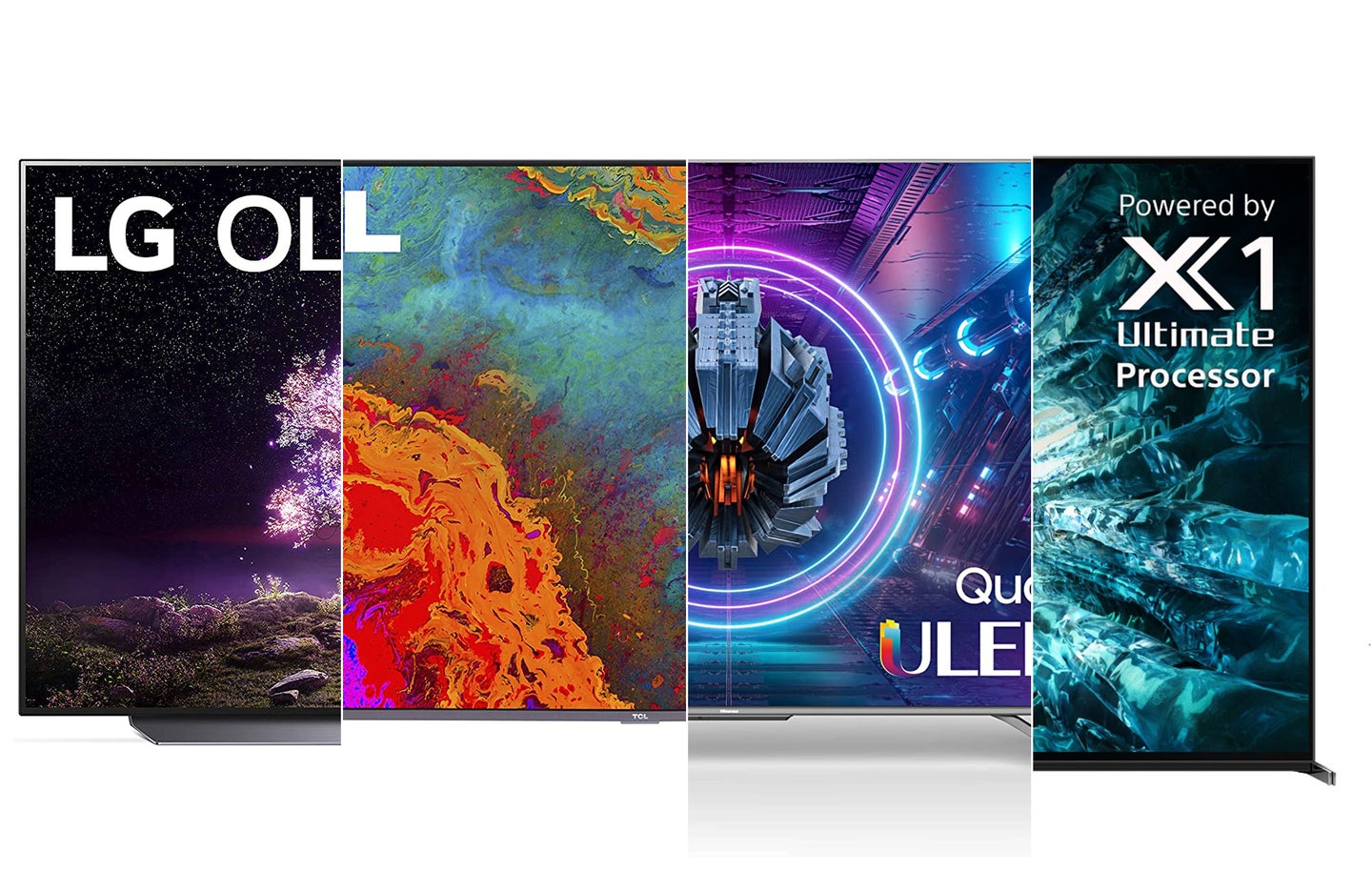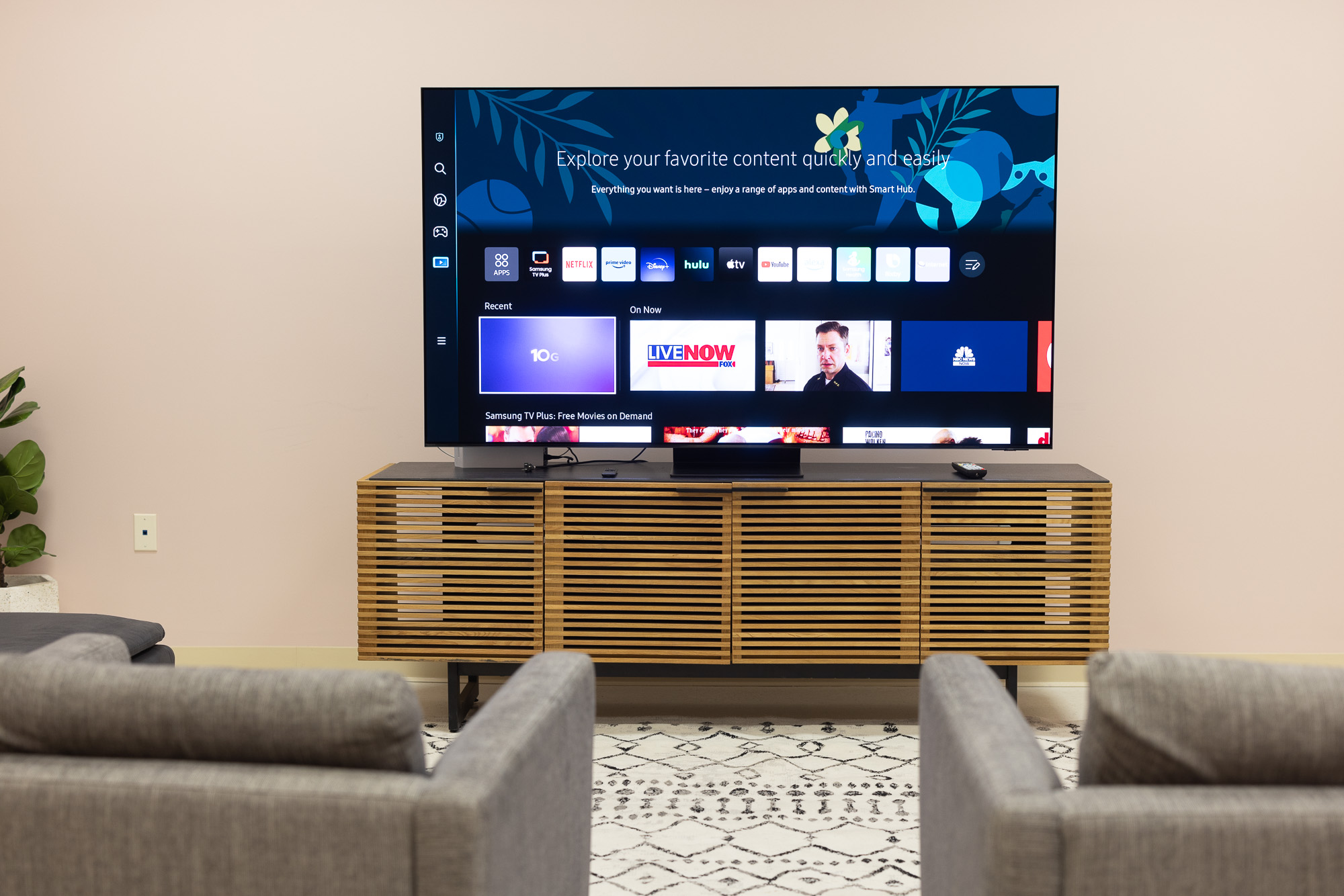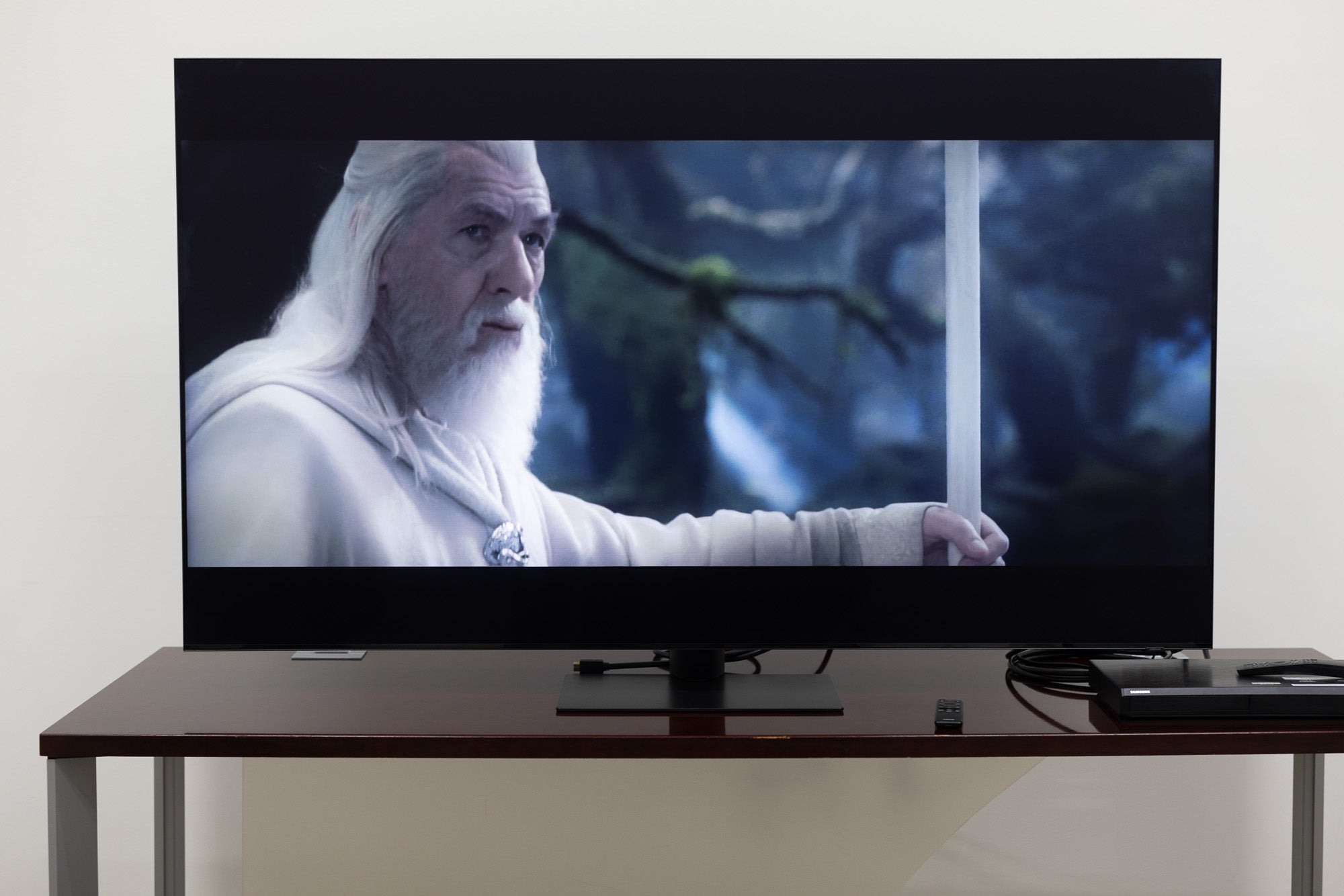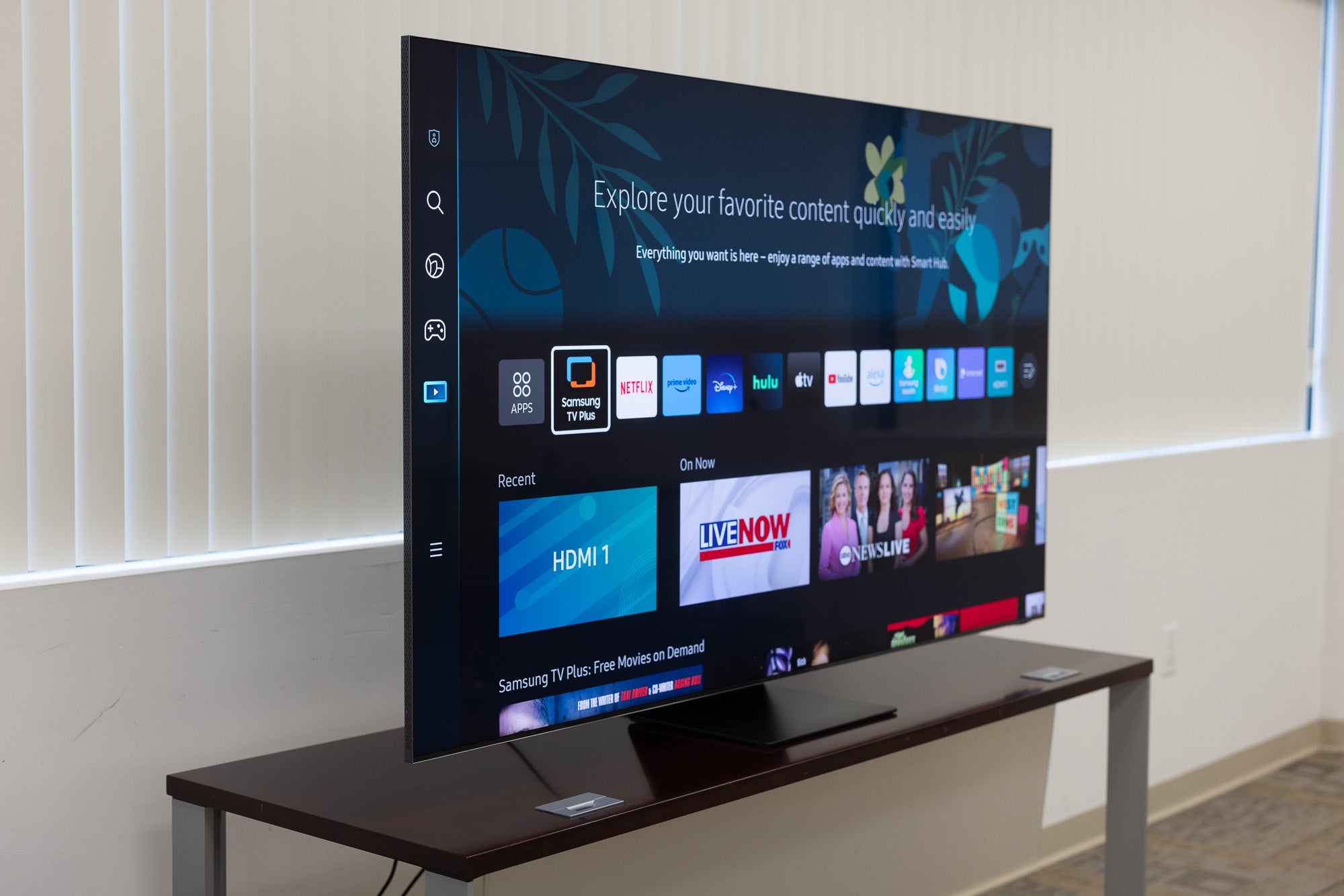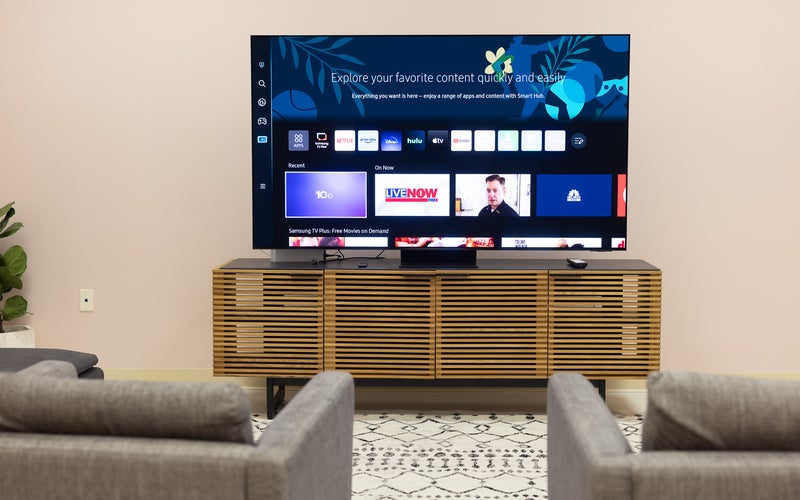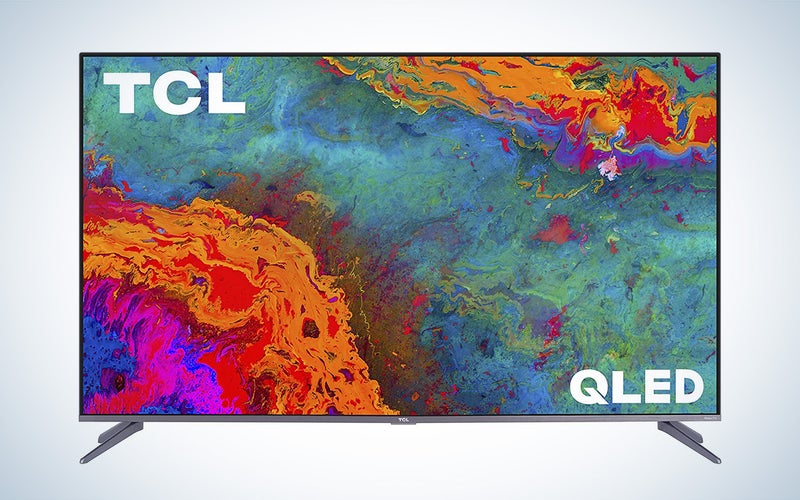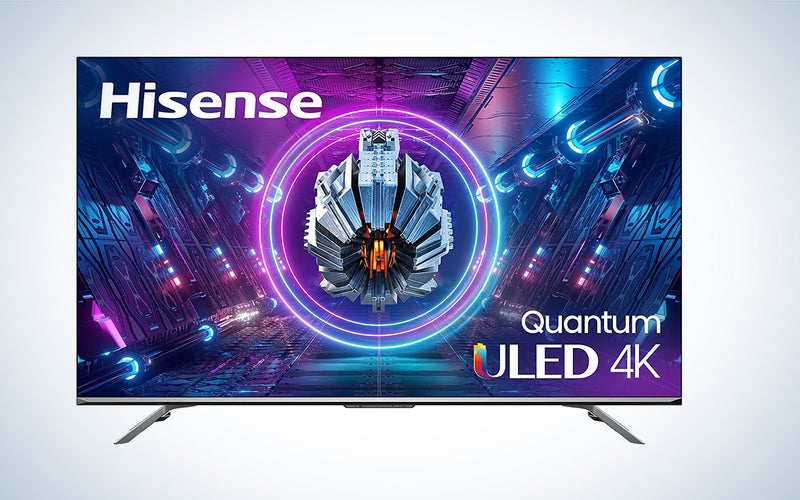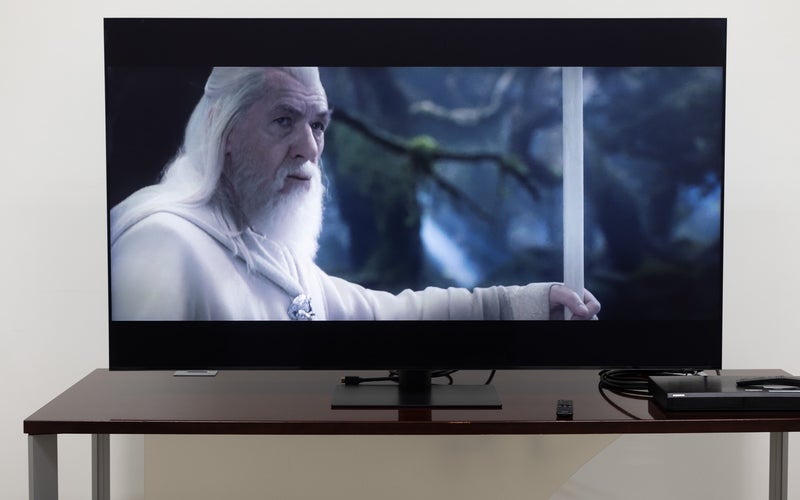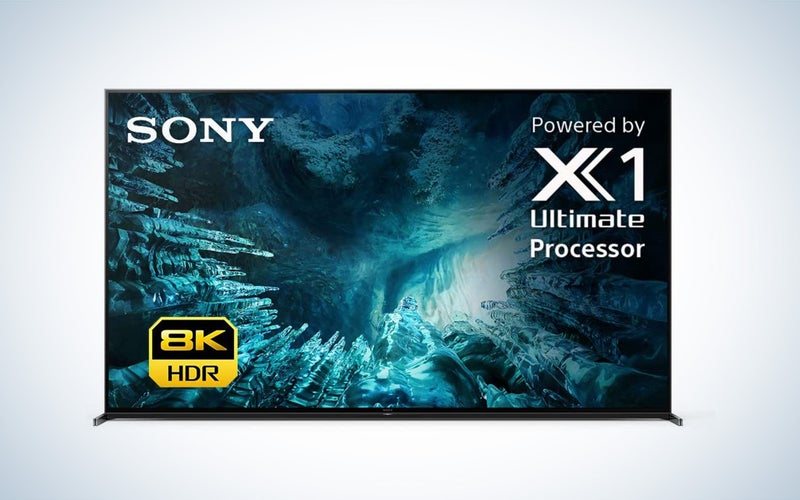We may earn revenue from the products available on this page and participate in affiliate programs. Learn more ›
The future is now, you lucky PlayStation 5 owner you. The gameplay! The graphics! The sheer jealousy all your friends feel because you snagged the most in-demand piece of electronics of the last year! Your gleaming white monolith certainly deserves a place of honor on the shelf of your entertainment center. But what’s this? Are you not showing your gleaming obelisk of leisure the proper respect by pairing it with (GASP!) an inferior television? If you’re worried that you aren’t getting the most eye-popping visuals out of your PS5, this guide should help you find a proper set to brighten and sharpen your screen and amplify your friends’ envy. From 4K to 8K, HDMI 2.1 to variable refresh rates, we’ve got all kinds of TV upgrades here so you can have the best TVs for PS5 gameplay.
How we selected the best TVs for PS5
To find the best TVs for PS5, we surveyed dozens of reviews and testimonials, eliminated sets that didn’t offer the most important game-boosting features, and demoed the final selections in-store in order to ensure these were the right TVs for the job. Like the world warriors of Street Fighter, any of these sets could come out on top if they meld with the right player, it’s just a matter of matching your style and desire to your 4K (or 8K) combatant.
- Best OLED: Samsung S95C OLED
- Best budget: TCL 5-series
- Best for single-player experiences: Hisense U7G series
- Best QLED: Samsung QN90C series
- Best 8K: Samsung QN900C Neo QLED 8K Smart TV
The best TVs for PS5: Reviews & Recommendations
Playing PS5 on the best TV possible makes a huge difference in bringing your games to life. These televisions won’t just satisfy you, some will electrify you and bring your console to its full potential.
Best OLED: Samsung S95C OLED
Stan Horaczek
Why it made the cut: Samsung mixed Quantum Dots with its OLED technology to maintain the absurd OLED contrast ratios while cranking up the brightness.
Specs:
- OLED display
- HDR10+ certified
- FreeSync Premium and G-SYNC compatible
- 120Hz refresh rate
- 4 HDMI 2.1 inputs
- Available sizes: 55”, 65”, 77”
Pros:
- Every feature you need for gaming
- Extremely high-quality image
- Brighter than a typical OLED
Cons:
- Expensive
OLED TVs offer spectacular contrast ratios thanks to their unique backlight technology. Each pixel provides its own light, which allows them to turn completely off when they’re not needed. Those extra-dark areas make the colors and bright sections of the screen really pop. The downside, however, is that OLEDs typically can’t get that bright. Samsung, however, has introduced Quantum Dots into the equation, which raises the overall brightness without stepping on the benefits that come with OLED.
This TV has everything a gamer needs. It has a fast refresh rate, super-low input lag, and four HDMI 2.1 ports in order to get the most out of a current-gen console like the PS5. All of the ports live on a box that attaches to the super-thin screen with a single wire so you have options when it comes to how and where you want to mount the TV.
I got an early chance to test this TV at a Samsung facility. I brought my own PS5 and used it to play Returnal. The S95C pumped out a very steady stream of crisp, poppy images with no lag or odd image artifacts. Even with the lights turned on, the picture is remarkably clear and resilient toward glare. While this TV isn’t cheap, it offers a very excellent all-around option that excels when you bust out the controllers.
Best budget: TCL 5-series
TCL
Why it made the cut: The vast majority of next-gen features really bump up the price of a TV, so it’s hard to find something truly PS5-worthy at below $1,000. If you just want a really good 4K screen without worrying about refresh rates and HDMI 2.1, though, the TCL 5-series is an excellent choice at a great price.
Specs:
- QLED display
- Auto Low Latency Mode
- 4 standard HDMI inputs (1 eARC for easier audio set-up)
- Google TV or Roku TV streaming apps built in
- Siri, Alexa, and Google Assistant support
- Sizes: 50”, 55”, 65”, 75”
Pros:
- Low cost of entry
- Good image quality for the price
- Includes ALLM for improved gaming
Cons:
- No HDMI 2.1
The future isn’t cheap, and after spending $500-$600 on a PS5, another $100-$200 on accessories, and a further $200-$300 on games, you may not want to spend another $1,000 bucks or more on a new TV. The TCL 5-series is a 4K QLED panel that will really impress you with its clear colors and solid blacks. It features an “Auto Low Latency Mode,” or ALLM, which automatically switches the display to optimal settings when it detects a game console in one of its HDMI ports, reducing the need to manipulate the sliders yourself every time you want to switch. You’re not going to get the best framerates, but the 5-series starts at $600 for a 50-inch TV, so you’re also not going to be paying an arm and a leg, either.
Best for single-player experiences: Hisense U7G series
Hisense
Why it made the cut: While the Hisense U7G’s color, blacks, and viewing angles aren’t market-leading, it’s incredibly feature-rich with the next-gen settings and inputs you’d want at an approachable price.
Specs
- ULED display
- HDR10+ certified
- FreeSync compatible
- 120Hz refresh rate
- Auto Low Latency Mode
- Variable Refresh Rate
- 2 HDMI 2.1 inputs, 2 standard HDMI inputs
- Google Assistant built-in
- Sizes: 55”, 65”, 75”
Pros:
- Lowest-cot set to include all relevant next-gen features
- Freesync for PC gaming
- 2 HDMI 2.1 ports
Cons:
- Narrow viewing angle
- Limited sizes
Hisense’s U7G model is built with gaming in mind. Hisense packed nearly every relevant next-gen gaming feature into it: HDR10, 120Hz refresh rate, two HDMI 2.1 ports—all the key specs. It even features FreeSync variable refresh rate technology, which enhances the U7G’s performance when paired with a gaming PC. And the price point is incredible, with the 55-inch model starting at $850.

So there has to be a catch, right? There are a couple of minor ones. First of all, more advanced settings do mean more complex adjustments, so don’t expect the fastest setup if you want the optimal experience. Also, the viewing angles on the U7G are limited compared to some of our other recommendations, so you’ll want to sit directly in front of the panel to get the full glory of its pristine picture. While this means group multiplayer sessions in the living room might have some discernably “better” seats, it’s a non-factor if your gaming setup is for you alone. Overall, the screen quality is a tremendous upgrade over most TVs from even a couple years ago. And little touches help you get the most out of an already value-packed set. HDMI ports are clearly labeled with different Hz capabilities. And the two feet, which are secured via two screws, can attach to two different spots depending on how wide your TV stand is.
Best QLED for PS5: Samsung QN90C series
Stan Horaczek
Why it made the cut: Samsung’s Neo-QLED combines Mini LED backlighting with Quantum Dots for exceptional color and superlative brightness.
Specs:
- Mini-LED QLED display
- HDR10+ certified
- FreeSync Premium and G-SYNC compatible
- 120Hz refresh rate
- Variable Refresh Rate
- Available sizes: 43″, 50”, 55”, 65”, 75”, 85”
Pros:
- Wonderfully bright screen that keeps clarity in a sunny room
- Wide variety of sizes
Cons:
- Pricey
Quantum Dots and Mini LED backlighting combine to make this a
Best 8K: Samsung QN900C Neo QLED 8K Smart TV
Sony
Why it made the cut: In 2021, 8K is an unnecessary luxury, but the Sony Z8H is a great choice if you want to treat yourself.
Specs:
- 8K display
- 120Hz refresh rate
- Variable Refresh Rate
- 4 HDMI 2.1 inputs
- Available sizes: 75”, 85”
Pros:
- Clear jump in image quality over 4K
- HDMI 2.1
- Strong customer support
Cons:
- Very little native 8K content available
- Expensive
Right now, you’re very limited when it comes to native 8K content, but that doesn’t mean an 8K TV isn’t useless. This high-end panel offers some of the most advanced AI-powered content upscaling available, which makes even regular HD content look good. Of course it offers all the familiar features you’d expect out of a flagship display. It has four HDMI 2.1 ports, all of which live on a stand-alone box that makes it easy to install in just about any spot.
Testing with my PS5 at the Samsung facility, I was able to run some games of Overwatch 2. The action was colorful and smooth, with very little input lag and no image tearing. Samsung has really upped its gaming capabilities in recent years and this will be a solid performer for years, even as the PS5 enables high-res and high-frame-rate gameplay.
What to consider when picking the best TVs for PS5
The key to picking a TV to pair with a PS5 is knowing that it has some features that you can take advantage of right now, and some that will be more important in the future. Every single one of the televisions we’ve listed will have a great display with deep blacks, 4K (or better) resolution, and vibrant colors. Some will be able to take advantage of higher framerates and visual features that will improve the game image even further. Of course, all the TVs also have streaming apps, and some even have smart home compatibility. Taking these as a baseline, we looked at price and display technology as the true separation factors, and came up with the following categories.
Cost
There are some basic features that you’re going to be looking for in the best TVs for PS5. Many of these features are new to the market, and weren’t available on any TV before two or three years ago. Therefore, finding a TV that includes everything you’d want to see the PS5 at its best is relatively difficult and undoubtedly expensive. While we’ve included a budget-conscious option, the vast majority of televisions that we recommend to pair with a PS5 are going to be more than $1000. If you’re not necessarily looking for every single next-gen feature, there are plenty of great screens that will look amazing even if they don’t produce the absolute best possible picture.
HDMI 2.1—An introduction to PS5 resolution and framerate
The main television technology that allows the PS5 to shine is HDMI 2.1. HDMI is the port that connects your audio and video between your gaming system and television. The HDMI standard has been the standard since the mid-2000s, but HDMI 2.1, the latest iteration of this tech, didn’t start appearing on televisions until 2018. HDMI 2.1 allows for a much larger amount of data to be sent and received between the console and the display, unlocking the highest resolutions at the best framerates.
The PS5, at its maximum, can output 4K resolution at 120 frames per second. Keep in mind that very, very few games actually meet this maximum benchmark at this time, as processing demands can greatly affect that framerate. The last Sony console, the PS4 Pro, could manage 4K and 60fps at maximum, but few games ever reached that maximum either. The 4K/60fps threshold is much more reasonable for the PS5, and HDMI 2.1 (along with the more powerful processor and chipset of the PlayStation 5 itself) allows for that.
What about 8K resolution?
As of this moment, the PS5 does not support 8K resolution output. Some features of the PS5, such as the ability to install a secondary hard drive, weren’t activated at launch. Sony says these features, including 8K video and gaming, will be added via firmware over time.
In the meantime, there is still some visual benefit to playing PS5 games on an 8K TV. Much like how a 1080p HD image on a 4K television looks better on a 4K television, a 4K image on an 8K television will still look better because of upscaling tech in the console and the television. We have included an 8K television in our list, but it isn’t our top recommendation since you’ll be buying into the technology ahead of really needing it.
For what it’s worth, there’s very little content currently available in 8K. It’s unclear how well the current crop of PS5 games would run at that resolution, and most streaming services cap their videos at 4K. So almost everything you watch on an 8K is upscaled. By the time 8K gaming, streaming, and movies are readily available, the 8K television you buy today may be obsolete in other ways. Long story, short: playing PS5 games in 8K is a nice idea, but far from a necessity.
What non-gaming features do I want?
You probably aren’t only going to use your TV to play PS5. All of the televisions included in this list have “Smart TV’ features, meaning your options for streaming are to stream through the downloadable apps on your PS5 or through apps you can download directly to your television. (You can also watch most of them through the PS5. We recommend the PS5 streaming apps over many of the ones found in smart TVs). Some of the televisions can also connect to other services, such as home assistants like Amazon Alexa and Google Assistant. These features don’t weigh too heavily in this list, as they don’t affect your gaming experience.
The other main consideration is audio. Even the nicest televisions have pretty ordinary sound output on the built-in speakers. Truly great sound demands its own system. For playing PS5 games, we strongly recommend players purchase a headset, which can take unique advantage of the console’s Tempest 3D audio technology. For recommendations on speakers for watching TV and movies, please check out our picks for the best soundbars and the best surround sound systems for home theaters.
FAQs
Q: Which TV brand service is best?
Sony truly shines when it comes to customer service, first offering high-quality sets with very few problems, and later addressing issues with high levels of customer satisfaction if problems happen to occur. LG, Hisense, and TCL tend to let retailers cover a lot of the rarely-occurring early-purchase issues with their models. Samsung’s service ranks a smidge below Sony but has a good overall reputation for customer service.
Q: What are the worst TV brands?
When it comes to TVs, you tend to get what you pay for. Brands that specialize in low-cost displays tend to earn a reputation for buggy, breakable TVs. Some previously-well-regarded brands like RCA, Hitachi, and Westinghouse have fallen far behind their competitors, and tend to offer vanilla, cheap, featureless televisions that only appeal to people with an urgent need and little time or budget to comparison shop. In general, we strongly urge you to stick with brands with a reputation for quality. If you’ve never heard of the television maker, it’s almost certainly one to avoid.
Final thoughts on the best TVs for PS5
- Best OLED: Samsung S95C OLED
- Best budget: TCL 5-series
- Best for single-player experiences: Hisense U7G series
- Best QLED: Samsung QN90C series
- Best 8K: Samsung QN900C Neo QLED 8K Smart TV
Each TV on this list is a great fit for playing games on PS5. The LG C1 OLED is the critic’s pick, with incredible picture and a great feature set, but there are solid reasons to opt for a QLED screen over an OLED. And if a $1,000-plus isn’t in the cards, there are still plenty of ways to optimize your setup for high-end console gaming.
Even with our recommendations in hand, the best thing to do is to preview the floor models in a store. Your eyes will tell you what they like. No matter what model you choose, your PS5 is going to look great, and you’ll really get to make your friends jealous.
Why trust us
Popular Science started writing about technology more than 150 years ago. There was no such thing as “gadget writing” when we published our first issue in 1872, but if there was, our mission to demystify the world of innovation for everyday readers means we would have been all over it. Here in the present, PopSci is fully committed to helping readers navigate the increasingly intimidating array of devices on the market right now.
Our writers and editors have combined decades of experience covering and reviewing consumer electronics. We each have our own obsessive specialties—from high-end audio to video games to cameras and beyond—but when we’re reviewing devices outside of our immediate wheelhouses, we do our best to seek out trustworthy voices and opinions to help guide people to the very best recommendations. We know we don’t know everything, but we’re excited to live through the analysis paralysis that internet shopping can spur so readers don’t have to.
